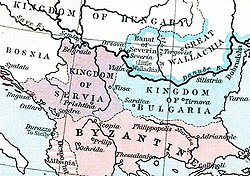Nemanjić Serbia
| Kingdom of Serbia | ||||||||||
| Краљевина Србија Kraljevina Srbija |
||||||||||
|
||||||||||
|
Serbia, 1265, during the rule of Stefan Uroš I of Serbia
|
||||||||||
| Capital | Ras, Skopje | |||||||||
| Languages | Serbian (Old Serbian) | |||||||||
| Religion |
† Eastern Orthodoxy (Serbian Orthodox Church) |
|||||||||
| Government | Monarchy | |||||||||
| King | ||||||||||
| • | 1196–1228 | Stefan Nemanjić (Grand Prince↑King) | ||||||||
| • | 1322–1331 | Stefan Dečanski | ||||||||
| • | 1331–1346 | Stefan Dušan (King↑Emperor) | ||||||||
| Historical era | Medieval | |||||||||
| • | Crowning of Stefan Nemanjić The First-crowned | 1217 | ||||||||
| • | Autocephaly of the Serbian Church (Sava, Archbishop of Serbs) | 1219 | ||||||||
| • | Crowning of Stefan Dušan (Emperor of Serbs and Greeks) | 16 April 1346 | ||||||||
|
||||||||||
| Today part of |
|
|||||||||
| Warning: Value specified for "" | ||||||||||
The Kingdom of Serbia (Serbian: Краљевина Србија/Kraljevina Srbija), or Serbian Kingdom (Српско краљевство/Srpsko kraljevstvo), was a medieval Serbian state that existed from 1217 to 1346, ruled by the Nemanjić dynasty. The Grand Principality of Serbia was elevated with the coronation of Stefan Nemanjić as king by his brother, bishop Sava, after inheriting all territories unified by their father, Stefan Nemanja. The kingdom was proclaimed an empire on 16 April 1346.
In 1083, Constantine Bodin, the King of Duklja and Ruler of the Serbs, had appointed his nephews Vukan and Marko as vassals in Rascia (historiographical name), one of the four provinces of his realm, situated in the hinterland along with Zachumlje, Bosnia, and the seat in Duklja. Each province had its own nobility and institutions, and each acquired a member of the Vojislavljevići to head as Župan. The Byzantine Empire launched a campaign on Duklja between 1089 and 1091 and possibly captured Bodin. A civil war broke out in the realm among Bodin's relatives, greatly weakening Duklja. Vukan took the opportunity to assert himself and broke away, claiming the title of Grand Prince of Serbia.
Rascia, Bosnia, and Zahumlje all became independent in 1091. Up to this point, Duklja had been the center of the Serbian realm, as well as the main resistance to Byzantium in the Balkans. After 1091 Rascia became the most powerful of the Serbian states, under the rule of the Vukanović dynasty, and it remained so throughout the rest of the Middle Ages. Rascia also replaced Duklja as the main opponent of Byzantine rule in the 12th century. Bodin's heirs were forced to recognize Byzantine overlordship, and now held only the small territories of Duklja and Travunia. During the reign of Vukan's son Uroš I, the Byzantines invaded Duklja and sought to conquer Rascia as well, but through diplomatic ties with Hungary, Serbia kept its independence. Uroš II initially fought the Byzantines, but he gave oaths of servitude to the Emperor after he was defeated in war. Desa, the brother of Uroš II and initially a Byzantine ally, turned to Hungarian support, but he was deposed in 1163 when Stefan Tihomir of a cadet line, which would become Nemanjić dynasty, was put on the throne by the Emperor.
...
Wikipedia


